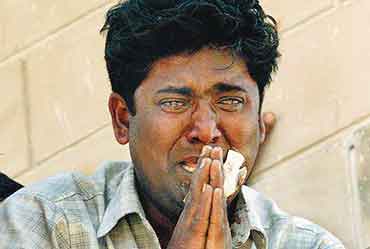This piece of mine has been published today in the Wall Street Journal Asia. (Subscription link.) It was written on Monday, before Sanjaya Malakar got voted off American Idol.
By the time you read this, Sanjaya Malakar might well have been voted off of American Idol. If so, you won’t hear many groans of disappointment from India. Mr. Malakar, a 17-year-old of Indian and Italian descent, has mostly slipped below the radar here. But if he continues to capture the attention of millions of Americans the Indian media will change its tune, and not out of a newfound appreciation of Mr. Malakar’s singing ability. More likely, the local press will celebrate him as an Indian talent applauded by the West.
Hardly anyone here watches the American Idol singing competion, which is telecast on Star World, an English-language channel that, in India at least, caters to the elite. The domestic media have mentioned Mr. Malakar, now a finalist in the competition, just a handful of times, and that too in the context of the derision he has received in America. The dearth of media chatter here almost certainly results from the fact that the American press doesn’t have too many good things to say about him.
Of course, India has plenty of its own celebrities to gush over, some of them even less talented than the young Sanjaya. India produces more films than any other country in the world. Products from Bollywood (the Hindi film industry), Kollywood (the Tamil film industry) and Tollywood (the Telugu and Bengali film industries both claim that title) have audiences many orders of magnitude larger than those of the few Hollywood films that actually get released here. Successful music albums in local languages, mainly film soundtracks, sell in the millions, while the best a Western album can achieve is a few thousand. Indian Idol, the local version of the American show (which is itself an import to the U.S. from the U.K.), inspires national debate and heartbreak, while most people have probably not seen American Idol even once.
But even with this flourishing pop culture, many Indians still crave validation from the West. We see this every year before the Oscars, when a national soap opera unfolds surrounding which film will be chosen to be India’s entry for the foreign-language film category. (Only three Indian entries have ever been nominated, and none has won.)
The media celebrated when an Indian was chosen to umpire at Wimbledon. Indian writers become celebrities for life when they get big advances abroad, or win British or American literary awards. News of Madonna practising Yoga or pictures of Gwen Stefani with a bindi on her head are treated by the media as tributes to Indian culture.
When Indian actress Shilpa Shetty participated in the British TV show Celebrity Big Brother, her progress in the show received extensive coverage in the local media. Racist remarks directed at Ms. Shetty by a couple of participants on the show sparked outrage across India. When Richard Gere kissed her at a recent AIDS-awareness event, one local report began triumphantly, “We’ve always known Shilpa Shetty is a pretty woman, but now we have an official endorsement from a visibly smitten Richard Gere.”
This sensitivity to India’s reception in the West cuts both both ways, of course. As news of Mr. Gere kissing Ms. Shetty spread, protests were held across the country, effigies of the actor were burned, and one protestor even gave sound-bytes about how the kiss had “blemished the rich Indian culture.” When designer Anand Jon was arrested in Los Angeles for alleged rape and sexual assault, much of the Indian press wrote up the story as if he had been framed. And so on.
This all raises the question: Why does India care so much about what the West thinks of it? Perhaps it is a legacy of colonialism, or just the inferiority complex of a developing country whose economic progress has not yet been matched by cultural self-confidence.
Whatever the reasons, this preoccupation with the West is needless. The films coming out of India’s booming industry, for example, hardly need the approval of foreign audiences. Shekhar Kapur, one of the few Indian filmmakers to have worked in Hollywood, often criticises the use of the label “Bollywood” to describe Mumbai’s film industry. His point is that Indian films function in a space of their own, and draw large audiences that prefer it to any other cinema. The industry hardly needs to pay homage to Hollywood, and India doesn’t need to look West in order to appreciate its own culture.
Indian attitudes toward Mr. Malakar are likely to be shaped by how he is received in the United States. Mr. Malakar may be more American than Indian, and he may be singing American pop that hardly sells here, but if Americans choose him as their idol he will become a source of national pride. That is all good for Mr. Malakar—but what does it say about India?
